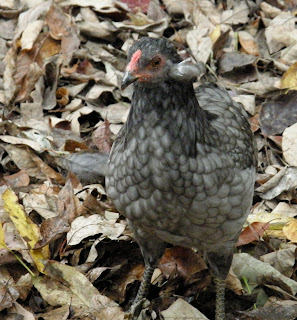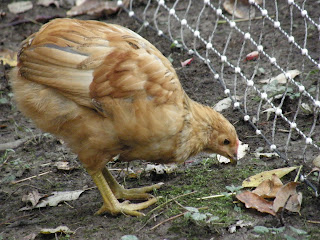Cicada
Cicada struggled through the winter and my learning curve mostly intact. His feet have some cold damage, but he never got outright frostbite, and he kept all his toes. I finally put him in the broody suite by himself in mid-February and he recovered. He walks a little awkwardly, but is now crowing and stalking Finn’s hens. He was slow to mature; while the first group of Araucana boys were all crowing by 15 weeks or so, Cicada never did until he was 6 months old. I still have him penned with Finn and the older hens and he’s still at a loss for company. I am hoping that I get some tufted pullets from Kiwi’s pen this summer to put him with.
The ash devastation
Spring was slow in coming this year, but just like last year, as soon as it warmed up Clucky went broody. She was soon followed by Hawk and Flicka. My hands have been tied in terms of moving the chicken enclosures around due to the “We’ll try to have it done by Christmas” ash tree removal. Maybe they meant THIS Christmas because it has yet to be completed. All the areas I had pegged for chickens require access for the tree crew. In March, I had to move Oriole’s flock to the broody suite where they remained until a couple of weeks ago. So my broodies have been biding their time.
This year's first brood
I finally took pity on Clucky and set her up in the dog crate inside the main coop. I put her on 12 eggs from both Oriole’s and Kiwi’s pens, from all the Araucana hens except Hawk (who remains broody). About halfway through, Clucky moved most of the eggs under her to the center of the crate, leaving 5 cooling in the corner. I’ve heard that hens can tell if eggs are bad and will pitch them out of the nest, but I suspect she chose to move with some eggs and then got “stuck” between the eggs she had and the ones she left behind. They were cold by the time I found them, so I removed them, leaving her with 7. Six of these hatched, all from Oriole’s pen. There are 4 little black/birchen chicks, one, Nightshade, with double tufts and 2 blonde stripy chicks. Although I don’t know which chick came from which mother, I now at least know that Oriole carries a wild type gene hiding under his “birchen-esque” coloration.
You plan to do what?!
I had set Hawk on 4 eggs from Kiwi x Magpie, but after Kiwi’s eggs failed to hatch under Clucky I added some from Oriole’s pen. The original eggs are due to hatch next week. If they fail, I will do some feather trimming on Kiwi’s group!
Wren's new saddle
In moving Oriole’s group from the broody suite, I saw my chance to gather some eggs that I knew for sure were from Wren. Her back is in pretty bad shape from Oriole’s attentions so I figured she could use a little break. I left her alone in the broody suite for a week (which she resented) and got 3 eggs from her in that time. I returned her with a hen saddle to her group and set Flicka on her eggs last week. So now we wait!
Oriole
They're waiting....
I had envisioned moving the fencing around Finn’s group often enough this summer so the woods/yard wouldn’t get decimated. But then I saw that the area in the woods where they were penned last year was coming back in a garlic mustard monoculture. In the interest of saving at least some of my woods from invasives and also being able to keep from having to move the labor-intensive fencing every two weeks, I went to Plan B. I found a company online that sells a pasture mix specifically for chickens so I’m in the process of setting up cells fenced with chicken wire (which will remain in place) within the big run and planting them. The company suggests letting the plants grow to 2-5 inches and then letting the chickens graze them down halfway, at which point I can close up the cell again. I think this will work well if I make enough “exclosures” and can keep up with the chickens.
Pasture greens




















































